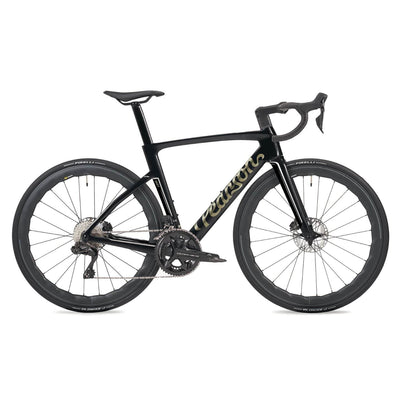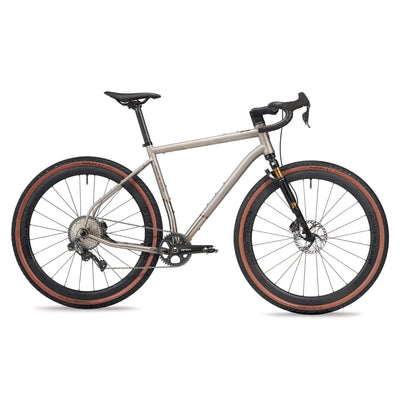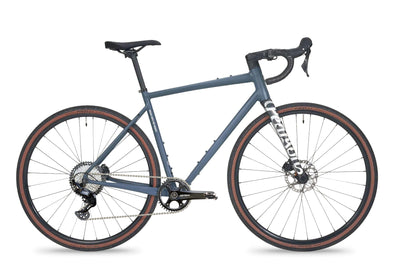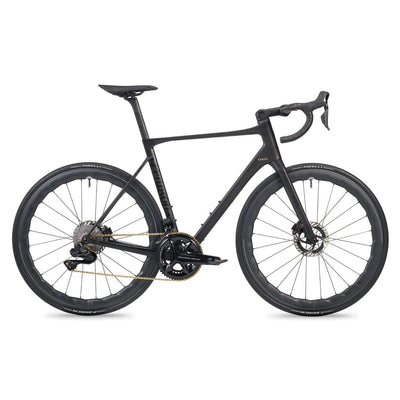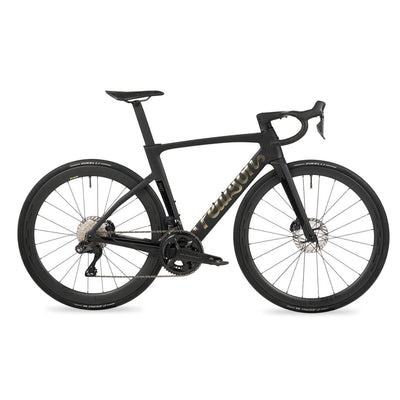How to keep your bike serviced at home
There’s a lot you can do to keep your bike running at its best, before you need to head down to the bike shop. Here are our tips on some of the easier servicing jobs you can do at home.

The basics of bike maintenance are pretty straightforward. Keeping your bike cleaned and lubed and the tyres pumped up will help prolong the life of your parts and keep them running smoothly.
How far you want to go beyond that depends on your enthusiasm, time available and having the right tools. A lot of bike servicing needs specialist tools, which can be quite pricey, so you might want to acquire the basic set then add to it slowly. A good set of Allen keys will get you a long way.

You can always book your bike into our workshop - we offer a complete menu of services from puncture repairs up to a complete strip down and safety check, with a transparent schedule of prices from a few pounds up to £140 plus parts for our Advanced Service.
Regular bike checks
It’s a good idea to get into the habit of checking your bike regularly for wear and tear. Some things should be checked before every ride, others need to be looked at every month or so.
Check your tyres
Tools: knife/small screwdriver
You should check your tyres regularly for wear and damage. Some brands like Continental include tread wear indicators in their rubber, so you can see when they need replacing. With others, you need to use your judgement on how worn the tyres are. Look out for the puncture protection strip or threads showing through the rubber in the tread. They’re a sure-fire sign that you need new tyres.

Cracks in the rubber, damage to sidewalls and flat spots may also indicate that you need to replace your tyres.
Inspect too for sharp stones or pieces of glass embedded in the tread and prise them out with the point of a sharp knife or the blade of a small screwdriver before they can work their way further in and cause a flat.
We've a guide to how to choose road bike tyres you can read and one on how to fit tubeless tyres and how to maintain them.
Check bolts are tight
Tools: Allen key set, torque wrench/preset keys
Make sure all the bolts on your bike are secure, especially if you hear rattling as you ride. Key ones to check are those on the stem and its faceplace, the seatpost and the saddle rails, although you’re likely to experience slipping bars or saddle if they’re not correctly set.

Check that thru-axles are tight or, if you have quick releases, that the lever is holding the wheels firmly in the dropouts.
Also check water bottle cage bolts, as they’re prone to loosen, and the bolts on your chainring spider.
Make sure you observe the torque figures on parts to avoid damage, as many bike bolts should only be tightened to a fairly loose 5Nm to 6Nm. It’s a good idea to use a torque wrench or the less expensive pre-set torque keys like those from Bontrager or Topeak to get them correct.
Check for play in headset bearings
Tools: Allen keys/Torx keys, torque wrench
Stand in front of your bike, apply the front brake hard and try to rock your bike back and forward. Hold your bike off the ground and move your bars from side to side. If there’s excessive play or they don’t move freely, you may need to adjust your headset bearings.

To do this, loosen the bolts in the rear of the stem and in the headset cap - you don’t need to take them out. Most bolts have 4mm hex heads, although some have Torx bolts.
Tighten the headset cap bolt until there’s no play in the bearings, but they still move freely. Then retighten the bolts in the stem to the correct torque figure.
Drivetrain cleaning
Tools: Chain cleaning fluid, chain cleaning tool, rags, small brush with stiff bristles, lubricant
Keep your chain, cassette, derailleurs and chainrings clean and you’ll increase their longevity and save a stack of cash on replacements, as well as reducing friction.

You can buy liquid chain cleaner/degreaser from brands like Muc Off and Morgan Blue. It’s worth buying a chain cleaning tool to make cleaning the chain easier and quicker too. Fill the reservoir up with degreaser and run the chain through the cleaner to remove the grease. It’s worthwhile to refill with soapy water afterwards and run the chain through the cleaner again to help remove any residual gunk.
As well as the chain, you should clean your cassette and your jockey wheels at the same time, which is where the stiff brush comes in, to work chain cleaner into the teeth. Again, give them a rinse with warm soapy water and rinse off with cold water.
Next dry the chain thoroughly with rags and apply a new coating of lubricant before the chain has time to get rusty.
Chain and cassette replacement
Tools: Chain wear indicator, cassette lockring spanner/nut, chain whip, chain tool
Your chain and cassette tend to be the first things to wear on your bike, however virtuously you clean them, and you should swap them both out at the same time when the chain has around 1% stretch in it, to reduce wear on your chainrings and help keep everything running sweetly.

Check for wear regularly using a chain wear indicator. It’s an inexpensive tool and handy to use to keep an eye on wear, even if you decide to get a workshop to do the work for you.
You’ll need to buy a new cassette and chain suitable for your bike as replacements.
Start by using the chain tool to remove the old chain, by pushing out one of the rivets. Take the wheel out of the bike and fit the lockring spanner, then unscrew the lockring using the chain whip to keep the cassette from turning.
Remove the cassette and fit a new one. Cassette sprockets have to be positioned correctly relative to one another and the right way round. There are two splines on the freehub that are spaced differently from the rest and need to be lined up with the corresponding slots in the sprockets, that prevent you from mis-fitting them.

Once you’ve got all the sprockets on the freehub body, fit the locknut and retighten. Be careful as freehubs tend to be quite fragile and it’s easy to damage the threads if you cross-thread the locknut. It needs to be screwed down pretty tight so that it holds everything together firmly as you ride.
Gear adjustment
Tools: Small screwdriver, allen keys
Poor shifting performance is a frequent problem. It’s commonly caused by cables stretching, so that a click of the shift lever doesn’t result in a single change up or down the cassette or the derailleur isn’t positioned precisely over the sprockets. It’s fairly easy to reindex your shifters to sort it though.
It helps if you can support your rear wheel off the ground, so that you can spin it easily, although you can flip the bike over instead.
First you need to make sure that the high and low limit screws on your rear derailleur are set correctly. If the derailleur doesn’t shift into the highest and lowest sprockets, doesn’t run smoothly in them without chatter or drops off the cassette altogether, you need to adjust these screws.

They’re found on the rear of the derailleur body and are usually marked H and L. Screw them in or out a half turn or so at a time and spin the gears to make sure that the chain now runs smoothly.
If you get chatter on sprockets in the middle of the cassette you can use the barrel adjuster on the derailleur to fine-tune where the derailleur is positioned relative to the cassette. If you can’t engage the largest sprocket, however, you may need to unscrew the cable locknut and pull some cable through before retightening it and using the barrel adjuster to line up your derailleur with the sprockets again.
Your derailleur should sit just above the cassette if you’re in the largest sprocket, but if it rubs against the cassette, this position too can be altered via a screw further up the rear of the derailleur body, which pushes against the bike’s mech hanger.
At the front, you may get rubbing of the derailleur cage when you’re running at either end of the cassette, or the chain may persistently drop off one or other side of the chainset when you change rings. Again there are high and low limit screws on the derailleur body you can use to adjust how far over the derailleur cage sits. There should be between 1mm and 3mm clearance between the side plates and the chain in your highest and lowest gears.
You should also have an adjustment barrel somewhere in the cable run, allowing you to tighten or loosen the cable for efficient shifting. This might be a separate piece in the cable line from the bars, or on modern Shimano derailleurs is built into the mechanism.
Gears still not shifting smoothly? Main cause is likely to be contaminated or damaged cables. You might improve the situation by lubricating them, or may need to replace them.
A bent derailleur hanger can also cause poor drivetrain and shifting performance, particularly if you’ve crashed your bike or it’s fallen on the rear derailleur. This probably means a trip to a shop or a replacement, although it too can be sorted if you have the right tools. But derailleur hangers are delicate so you may snap it if you try to bend it back into shape yourself without tools.

If any of this feels too much to deal with at home, as mentioned above, we’re happy to help, can give advice and can sort the problem for you.
1 comment
Nice Blog. Thanks For Giving this Information.


